We landed on Espumilla Beach before breakfast to walk along the shore and look for different species of birds and green sea turtles. This beach is an important nesting site for East Pacific green sea turtles. This morning, we observed several females and males. We spotted some couples mating in the water and fresh turtle tracks along the beach.
There was a lot of activity as a shoal of sardines attracted blue-footed boobies and brown pelicans. We were delighted to see these birds plunge-diving in front of us. We spotted a Galapagos hawk as it patiently watched people walking and taking pictures of it. Some Galapagos mockingbirds started to get close to the hawk, but this top predator was indifferent to their presence.
Later in the morning, National Geographic Endeavour II repositioned to Buccaneer Cove for kayaking, paddleboarding, and snorkeling. We also deployed the glass-bottom boat for tours so our guests could observe the Galapagos marine life.
A few times people tried to colonize Santiago Island, but these attempts failed. When we went ashore this afternoon, we saw evidence of the last time someone tried to live here.
We experienced some heavy rain, but it did not stop us from exploring the coast of Puerto Egas. The effort was well worth it, as we found a juvenile Galapagos hawk perched on a cactus, Galapagos fur seals, marine iguanas, and shorebirds looking for food along the coast. The rain subsided, and it was refreshing to walk along the trail with the sounds of rain and the sea.
We returned aboard at the end of the afternoon and had a great time during recap session as we recounted all the things we did today.
Photo caption and photographer: An adult Galapagos hawk roosts in a small tree as it watches people pass by. Photo by Gilda Gonzalez







